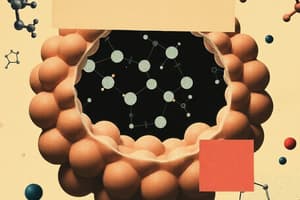Podcast
Questions and Answers
What are the four classes of large biological molecules?
What are the four classes of large biological molecules?
- Proteins, carbohydrates, lipids, and fatty acids
- Carbohydrates, proteins, nucleic acids, and minerals
- Carbohydrates, lipids, proteins, and nucleic acids (correct)
- Carbohydrates, vitamins, proteins, and lipids
Which reaction joins two monomers together to form a polymer?
Which reaction joins two monomers together to form a polymer?
- Oxidation reaction
- Hydrolysis
- Condensation reaction
- Dehydration synthesis (correct)
What is the primary role of monosaccharides in cells?
What is the primary role of monosaccharides in cells?
- As a major fuel for cells and raw material for building molecules (correct)
- To store genetic information
- To serve as a structural component for cellular membranes
- To facilitate enzyme activity in metabolic processes
Which of the following statements about polymers is false?
Which of the following statements about polymers is false?
What does hydrolysis do to polymers?
What does hydrolysis do to polymers?
Which macromolecule is primarily composed of sugar building blocks?
Which macromolecule is primarily composed of sugar building blocks?
What is the most common monosaccharide?
What is the most common monosaccharide?
Which of the following processes involves the removal of a water molecule?
Which of the following processes involves the removal of a water molecule?
What type of linkage connects sugar monomers in polysaccharides?
What type of linkage connects sugar monomers in polysaccharides?
Which of the following is FALSE about starch?
Which of the following is FALSE about starch?
What distinguishes cellulose from starch?
What distinguishes cellulose from starch?
What is the primary structural component of plant cell walls?
What is the primary structural component of plant cell walls?
Why can't enzymes that digest starch break down cellulose?
Why can't enzymes that digest starch break down cellulose?
Which statement about chitin is TRUE?
Which statement about chitin is TRUE?
Which of the following best describes lipids?
Which of the following best describes lipids?
What feature gives lipids their hydrophobic nature?
What feature gives lipids their hydrophobic nature?
What structure do phospholipids form when added to water?
What structure do phospholipids form when added to water?
What is a key characteristic of steroids?
What is a key characteristic of steroids?
Which type of protein is primarily involved in facilitating chemical reactions?
Which type of protein is primarily involved in facilitating chemical reactions?
What is the main function of transport proteins?
What is the main function of transport proteins?
What is the primary role of cholesterol in cell membranes?
What is the primary role of cholesterol in cell membranes?
Which of the following is NOT a function of proteins?
Which of the following is NOT a function of proteins?
What type of protein would be most important for muscle contraction?
What type of protein would be most important for muscle contraction?
Which monomers are used to build proteins?
Which monomers are used to build proteins?
What is a common cause of starvation?
What is a common cause of starvation?
Which symptom is associated with ketosis?
Which symptom is associated with ketosis?
What characterizes marasmus?
What characterizes marasmus?
What causes lactic acidosis?
What causes lactic acidosis?
What is a symptom of familial hypercholesterolemia?
What is a symptom of familial hypercholesterolemia?
Which disorder is characterized by early onset heart disease?
Which disorder is characterized by early onset heart disease?
What is a common cause of obesity?
What is a common cause of obesity?
What type of tests are used to diagnose atherosclerosis?
What type of tests are used to diagnose atherosclerosis?
What determines the tertiary structure of a protein?
What determines the tertiary structure of a protein?
Which of the following proteins is classified as a fibrous protein?
Which of the following proteins is classified as a fibrous protein?
What is the main consequence of a single amino acid substitution in hemoglobin?
What is the main consequence of a single amino acid substitution in hemoglobin?
Quaternary structure is formed by which of the following?
Quaternary structure is formed by which of the following?
Which type of interaction is NOT involved in determining the tertiary structure?
Which type of interaction is NOT involved in determining the tertiary structure?
Which disorder is characterized by a lack of carbohydrates leading to metabolic complications?
Which disorder is characterized by a lack of carbohydrates leading to metabolic complications?
Which interaction strengthens the protein's structure in tertiary formation?
Which interaction strengthens the protein's structure in tertiary formation?
What symptoms are associated with hypoglycemia?
What symptoms are associated with hypoglycemia?
Flashcards are hidden until you start studying
Study Notes
Large Biological Molecules
- Four main classes of large biological molecules: carbohydrates, lipids, proteins, and nucleic acids.
- Macromolecules are formed by joining small organic molecules, characterized by their large size and thousands of atoms connected by covalent bonds.
- Molecular structure directly relates to function.
Macromolecules as Polymers
- Polymers are long-chain molecules made of similar building blocks called monomers.
- Carbohydrates, proteins, and nucleic acids are primary examples of polymers in biology.
Polymer Synthesis and Breakdown
- Dehydration synthesis (condensation reaction) combines monomers by removing a water molecule.
- Hydrolysis is the reverse process, breaking polymers into monomers by adding water.
- Enzymes act as organic catalysts to accelerate these chemical reactions.
Diversity of Polymers
- Cells contain thousands of different macromolecules that vary among and within species.
- A small set of monomers can create an immense variety of polymers.
Carbohydrates: Fuel and Structure
- Carbohydrates consist of sugars and their polymers, with monosaccharides as the simplest form.
- Common monosaccharide: glucose (C6H12O6).
- Polysaccharides are formed from linked monosaccharides via glycosidic linkages.
- Disaccharides are produced through dehydration reactions joining two monosaccharides.
Polysaccharides
- Serve two main roles: storage and structural functions determined by monomer types and glycosidic linkages.
- Storage polysaccharides include starch (for plants) and glycogen (for animals).
- Structural polysaccharide: cellulose, a key component of plant cell walls with specialized glycosidic linkages.
- Chitin provides structural support in exoskeletons of arthropods and fungal cell walls.
Lipids: Diverse Hydrophobic Molecules
- Lipids do not form polymers and are primarily hydrophobic due to hydrocarbon composition.
- Phospholipids self-assemble in water, forming bilayers crucial for cell membranes.
- Steroids, including cholesterol, consist of four fused ring structures and play a role in cell membrane integrity.
Proteins: Multifunctional Polymers
- Proteins constitute over 50% of cellular dry mass, serving various functions: structural support, transport, signaling, and catalysis.
- Amino acids are monomers that combine to form proteins (polypeptides).
- Types of proteins include enzymatic, structural, storage, transport, hormonal, receptor, contractile, and defensive.
Protein Structure
- Proteins exhibit four levels of structure: primary, secondary, tertiary, and quaternary.
- Secondary structure includes alpha-helices and beta-pleated sheets formed by hydrogen bonds.
- Tertiary structure is formed by interactions among R groups, while quaternary structure involves multiple polypeptide chains.
- Changes in DNA sequence can alter protein structure and function, illustrated by sickle-cell disease.
Disorders Related to Carbohydrates
- Carbohydrate deficit disorders arise from insufficient carbohydrate intake/metabolism, causing various health issues such as:
- Hypoglycemia: symptoms include weakness and confusion due to excessive insulin or inadequate intake.
- Ketoacidosis: leads to nausea and fruity breath, primarily in diabetics.
- Glycogen Storage Disease: varies in symptoms based on enzyme deficiencies resulting in hypoglycemia.
- Starvation: results in extreme weight loss and muscle wasting.
- Ketosis: marked by fatigue and nausea due to low carbohydrate availability.
- Lactic Acidosis: muscle pain and fatigue from lactic acid accumulation.
- Hypoglycemic Shock: severe blood sugar drop causing confusion and seizures.
Disorders Related to Lipids
- Abnormal lipid levels cause cardiovascular and metabolic disorders, including:
- Hyperlipidemia: often asymptomatic; can lead to cardiovascular disease.
- Atherosclerosis: caused by lipid buildup in arterial walls, leading to chest pain.
- Familial Hypercholesterolemia: early heart disease due to genetic factors affecting cholesterol metabolism.
- Obesity: excess body fat linked to high caloric intake and low physical activity.
- Lipid Storage Disease: genetic conditions causing defective lipid metabolism, with varying symptoms.
Diagnosis and Treatment
- For carbohydrate disorders: blood tests for glucose levels, dietary management, and enzyme replacement therapy (for GSD).
- For lipid disorders: lipid panels and imaging tests for atherosclerosis are key diagnostic tools.
Studying That Suits You
Use AI to generate personalized quizzes and flashcards to suit your learning preferences.




